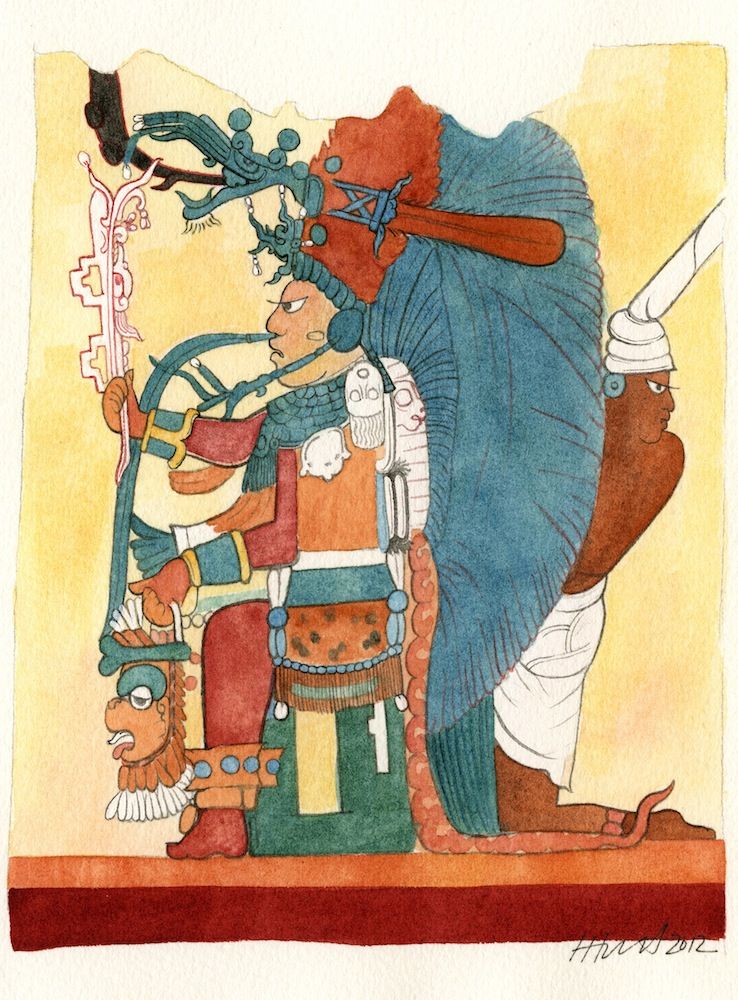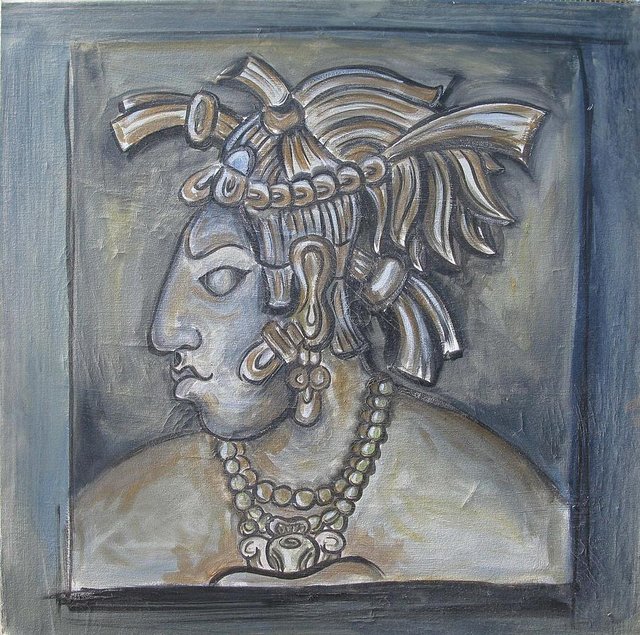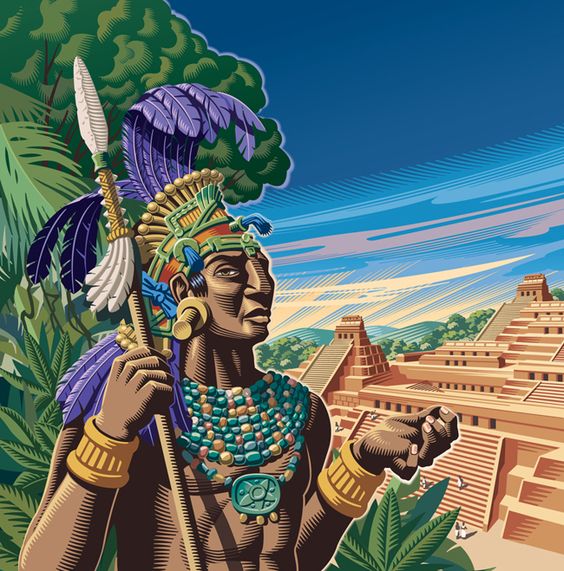Skycae's Ancient History Blog - Ancient Mayans and Babylonians #2 - Kingship
Hello Steemit, today has been another wonderful artfully productive day for me. I got a lot of art done, I love this wave of inspiration and finesse that is occurring in my life. It's nice to just settle down at home for a week or something and enjoy the alone time and cosy winter days. I also have time for research and writing and am happy to share with you the second part of my exploration and comparison of the ancient Mayans and Babylonians.
In the first post, I gave an introduction to the two civilizations and my motivations for studying them, and today I am going to try and tackle the important topic of kingship. In this post I am going to focus on the Mayans because there is a lot of information to cover and I want to avoid making it too long. This account is in no way complete, there is a lifetime of research to be done to fully understand the extensive topics covered here. I will get into it now.

A Mayan Ahau in costume
The institution of kingship is often what separates tribal, nomadic people from city-folk and great civilizations. All civilizations still have their roots in the villages and elders of the past, and in tribes and small social groups. Many people live this way still, in small social groups, but the great civilizations such as Egypt, China and the Maya all have King ship in common. Kingship seems to be an organic occurrence across the globe, abet in many different forms. In the vast majority of cases, the King is seen as Divine. He is either a god, the decedent of a god, or carrying out the gods will. I honestly can not recal any case in ancient history where the King was not associated with gods or at least with spiritual practices, though I am sure there are a few obscure cases out there. The ancient Babylonian civilization, and the Maya, are no exceptions from this case, however their ideas of Kingship may be strikingly different.
The Maya began in small tribal settlements along the coast, where they had elders and important clans to lead them. At some point, maybe from their neighbors to the north or south, they came up with the idea of Kingship. It is believed that Kingship came about in order to combat social inequality, and when other villages began implementing the institution, the idea spread and put pressure on all the Mayan villages to adopt the idea of Kingship. The idea that they were innovating in order to combat social equality is seen in the purpose of Mayan Kingship, which was to connect the average people to the Divine. In the Forest of Kings the explanation is that people were growing discontented with the growing power and wealth of a few important tribes, and that Kingship helped combat this inequality by putting the important and wealthy people into service of the ordinary person. They Kings established their rule as well by claiming that they were the living counterparts of the gods. It should be noted that the Maya civilizations evolved not as a unified kingdom, but each village grew and adopted new practices independently, so there is variation on exactly how it all went down. These are generalized ideas.
"The lowland Maya established Kingship by first crowning their gods and then by proclaiming their living counterparts, the kings, as the direct descendants and spiritual manifestations of these gods." (Forests of Kings around page 114-117)
What this means is that since the King was divine, and shamanic in a way, the people saw him as fit to rule. Mayan Kings were called Ahau, and they were able to be Ahau because their gods were Ahau. There are two important gods that were widespread among many Maya, the Hero-Twins Hun-Ahau (venus) and Yax Balan (the Sun). As you can see, Ahau is in one of the twins name. The story of these two is another whole post. It could have been these two gods that the Ahau claimed to be descendant of, but there were others as well.

Another depiction of the ancient Mayan Ahau
Because the Ahau was a descendant of the gods, he was also the link between the people and the gods, and had very important tasks to carry out for this purpose. It could be said that the Ahau's main purpose was to enact the rituals and other spiritual tasks necessary for the people to thrive. The Maya believed in the spirits of nature, and their idea of heaven and hell is also very interesting. Spirit pervaded everything and could both be a blessing and a curse, depending on the peoples actions. I will only be able to touch on the intricacies of Mayan spirituality, as I do not know enough. That is for future posts. The main point here is that there was important rituals and tasks that they saw as essential to their survival, and with Kingship came those responsibilities.
One of the first tasks of the new Ahau's was to build temples in order to enact public ritual performances. The first temples were smaller and made it easier for the average person to see the performance, and as time went on they grew bigger and only nobles were aloud near the top where the important rituals were carried out. The temples of the Maya is another posts worth of information, but they are central to the Kings function. The ability to organize the labor and trade necessary for such monuments structures was something that only the King could do with all-inclusive power and organizing abilities. The rituals that occurred in and on these temples were diverse, and quite frequent. The Mayans found many events and reasons for ritual. They also had some peculiar customs that needed to be enacted, of which blood-letting is the most spooky and most fascinating.
The Mayans were fond of sacrifice, and saw it as mostly a normal part of life. I do not know when the practice became normal, but I do know that almost all of their festivals, events and rituals called for sacrifices and blood-letting. It seems extreme, but to them it was not, and they had certain moral and spiritual beliefs that played into it. Firstly, the Mayans went to war only to take captives, and only nobles went to war and were taken captive. Only later in Mayan history was conquest war practiced, and only then did a King rule multiple cities. They believed that the nobles blood fed their ancestors and the gods. Often the captives were decapitated and in the public eye on the temples. Also, as part of their life and death beliefs, which included an underworld and a heaven, they believed that people who were sacrificed (along with women who died in childbirth) got a free ride, per se, to the heavenly realm. In this way, being a sacrifice may be justifiable.
As well as noble sacrifices feeding the gods, the Ahau himself would offer his blood through bloodletting. All social classes seemed to practice blood-letting, which involved cutting a part of oneself with a sharp obsidian blade, and transferring this blood to pieces of paper to be burnt. Any part of the body could be cut, but for both men and women the tongue was the most sacred, and for men, the phallice. Yes, they cut themselves on the most sensitive areas in order to feed their ancestors, the ultimate act of piety. When enacting rituals, the king wore white cloth, and after his private bloodletting ceremony inside the temple, he came out to stand on top of the sacred mountain dripping and red with his own blood. This spectacle was of importance to most rituals (as far as I know). It was believed that only the Ahau could control and divert great spiritual power that accumulated, and that is why he was of imense importance, and often fasting and other ways to reach altered states of consciousness were used, along with the loss of blood. In many spiritual practices across the globe, altered states of consciousness were important to ritual. I am sure there were others, of course, that the Mayans used, certain plants and what not, but I am not versed in that knowledge.
Along with these rituals, the Ahau had mundane tasks to deal with as well, such as organizing labor for building temples and canals to divert floods, as well as organizing tribute labor for large scale agriculture. He also was in charge of long-distance trades, of predicting heavenly events, and many other things. There were also a few instances recorded where the Ahau was a woman. The Mayan Ahaus belonged to dynasties of Kings, who could trace their ancestry back to the gods. For this reason, they often employed propaganda outfront of the temples documenting their rule and their dynasty in order to prove to the people they were legit, and in many cases, the transfer of power was not a difficult one.
The Ahau was almost entirely reliant on the support of the community to rule. He did not keep a police force or army, and therefore there was no one to force the people to obey the King. If the crops failed, if their was disease or unrest, the blame fell on the Ahau for messing up rituals or organization. Thus, without the cooperation of the people, nobles and commoners alike, the King could do nothing. This also may have made it easier for the Mayans to abandon their great cities and the notion of Kingship later in their history.

Woah, now that is a whole lot of information, and it is just scratching the surface. In conclusion, the Mayan Ahau were the mortal counterparts to the Divine gods, and along with obeying the gods and spirits will they must also obey the will of the people, or else they would be without power or the right to rule. They used all sorts of propaganda to keep themselves in the place of power, and allowed the civilizations to flourish and focus on things such as astrology, writing and trade.
They were quite distinct from other civilizations and other kings, as we will see when we talk about Babylonians. Honestly, I could research for a few more decades and still not have a complete idea about this subject. They Mayans world was very complex and intriguing, and probably still is. They were a mystical, enchanting people, and they had a very interesting civilization. I often wonder what made them leave their cities and institutions and live again in small social groups, but again, that is another whole topic. There is tons of great and more specific information in the book I used for research, which gets into more specific settlements, the transmission of knowledge, and dates and names. I focused more on the big ideas for this post.
The majority of this information I found and interpreted from A Forest of Kings, The Untold Story of The Ancient Maya by Linda Schele and David Freidel. It is a book over 500 pages long and quite large, and is a great resource. My other resources can be found on my bibliography on my original power point project here. You can see on the original power point that I had to narrow down each subject quite a bit, so I am glad I can regurgitate the majority of information I gathered here on Steemit, where I do not have to make the words fit on a single slide.
I hope you Steemians enjoyed delving into the interesting realm of Mayan kingship, and hopefully are excited for the Babylonian counterpart post. I need to do a bit more research on the Babylonians, because I did not have a whole good book for information, and instead my resources are spread across the web. It takes a lot more synthesizing to get the ideas out of that. Until then, keep on Steemin on <3
This post has received gratitude of 1.00 % from @jout
You got a 0.27% upvote from @postpromoter courtesy of @jout!
thanks yo
@originalwork @untalented @steemiteducation
I think your supposed to spell it with a s at the end like this - @originalworks
great post keep up the good work
ahh oops thanks for pointing that out
Amazing! Painting. You are really very talented. I will keep coming back for more. :)
Thank you, I appreciate your support a lot. :) It makes me wanna post more haha
You are most welcome. I'm glad that I did a good thing. :)
This subject is very interesting to me! Thank you for sharing!!
Yeah its super fascinating. My favorite history subject is the Tuatha de Danaan of Ireland, which I will post eventually. The Mayans are interesting as well though, and I hope to start researching their spirituality more.
#gratitude
Well done. It seems to me that kings / pharaohs / Popes often place themselves as a representation of a god of some type. I see from your writing that it happened here too. I love the article and I learned much from it as well. Thank you for sharing. It helps me out tremendously. Thank you.
Your welcome. I think understanding the phenomenon of kingship is a good way to figure out how to not need it. Babylonian Kingship is even more important, and more relevant to your work and our lives. King Hammurabi of the first dynasty of Babylon created the first law codes, which you might find interesting. I have more research to do on that though. I think although the Mayans were used to bloodshed, they were in a much better place spiritually and with their civilization then the Babylonians, and the Mayans eventually abandoned the way of life talked about here. Maybe they realized kingship was not a good solution, as later in their history the Ahau became more obsessed with conquest, war and politics.
I'm actually REALLY interested in your post about the Babylonians as I ended my research with the Romans and Egyptians. My gut tells me it goes back to Babylon and I'm curious as to what your research will show. I look forward to that post with great anticipation!
I basically only know about the basics of Romans and Egyptians. I had a mushroom trip once where I thought I was Nebadcadnezzer and ended up crying because the guy we were hanging out with said he wanted to build a giant gold statue of himself and I felt that I knew that was a bad idea, there is a whole bible story about it. Wierd time lol. Anyways, it got me into Babylon, a seriously interesting civilization. A great deal of stuff we use today originated there, I am glad you are interested, I will try to post it soon, the king part at least!
Amazing post XD !!!!
thank you! stay tuned for more!!